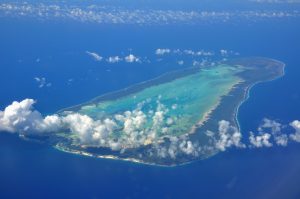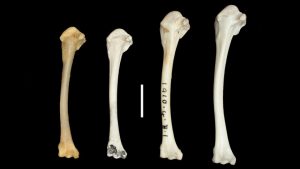Have you ever heard about Iterative Evolution? Iterative evolution refers to the repeated evolution of similar or parallel structures in the development of the same main line. There are many examples of iterative evolution in the fossil record, spanning a wide range of groups. This evolutionary conservatism probably is due to the overriding morphogenetic control exerted by certain regulatory genes. Aldabra bird is all about iterative evolution.
Iterative evolution or the evolving of same or similar structures from a single common ancestor could happen in different periods of time. Meaning, an animal is capable of coming over about two times in the history of evolution, completely separately. As much as it sounds bizarre, the theory is supported by the evidence of coming of The Aldabra rail (Dryolimnas cuvieri aldabranus) a species that went extinct 136,000 years ago, back to the earth twice.
A shallow lagoon encircled by a ring of islands, lies in the middle of the Indian Ocean, 280 miles to the Northwest of Madagascar. Those outcrops make up the Aldabra atoll, a place where mangroves flourish and Giant Tortoise roam free. However a different resident of atoll caught the attention of the world recently. That was none other than the Aldabra rail which is the headline of this article.

The Aldabra rail is a chicken-sized bird found exclusively on the atoll. Most importantly it happens to be that Aldabra rail is the only remaining island bird in the Indian Ocean, which is flightless. Weak arm muscles and asymmetrical flight feathers are what keep the bird grounded throughout its lifetime, literally.
The surprising fact is that the ancestors of Aldabra rail had the ability to fly. The Aldabra rail evolved from the white-throated rail (Dryolimnas cuvieri). White-throated rails inhabiting Madagascar and neighboring islands are birds that often takes to the skies even today. But, thousands of years ago, due to some reason, a number of these birds flew out to the Aldabra atoll.
Even then, large predators were not a common sight at the atoll. With lack of threat of predation birds’ descendants lost the ability to fly gradually. Well, as a matter of fact this is a very reasonable thing. When there’s no need to fly away from predators, can find food easily and flying is a high energy consuming process, why on earth they need to fly at all? Apparently Aldabra had same thoughts. So, as flight became unnecessary for short term survival, owing to the inheritance of acquired characteristics, after many generations the isolated rail population gave rise to the fully flightless birds we know today.
But, there’s nothing surprising in that. The plot twist in the story is that the above mentioned sequence of events happened more than once! Yeah, you read it correctly. A study carried in 2019, shows that, colonizing rails who could fly, came to Aldabra and begat a nonflying subspecies on two completely different occasions. It’s as if natural selection hit the “reset” button. This is the concept of Iterative Evolution.
University of Portsmouth biologists Julian P. Hume and David Martill co-authored the groundbreaking new study, which appeared in the Zoological Journal of the Linnaean Society on May 8, 2019.
An archeological dig site, On Ile Picard, the westernmost island of Aldabra atoll, yielded a pair of fossilized arm bones belong to prehistoric rails. Geologic clues shows that the bones are more than 136,000 years old. According to the distribution of marine fossils such as oceanic mollusk remains, it appears the atoll was completely submerged underwater multiple times during the past 400,000 years. Most recent one was about 136,000 to 118,000 years ago. The islands once again disappeared under the waves due to a rise in sea levels. Afterward, the waters retreated and the atoll re-emerged.

Then comes the best part of this story. The arm bones from Ile Picard dig site look almost identical to the ones we see in living Aldabra rails today which, as mentioned above, are flightless. Hence suggests that, the birds those fossils belonged to, were also probably flightless. So theoretically, what happened was, when the atoll flooded, the prehistoric rails in question were unable to escape and got wiped out. Shame they didn’t have a flood insurance policy or an emergency backup plan.
However, the sequel continues from there. As Hume and Martill explain in their paper, from Grand Terre, another island in the atoll, fossilized foot bone of a much younger rail was once extracted. That particular specimen is only about 100,000 years old. It means that, Ergo, the owner of Grand Terre foot bone, lived after the sea levels went back down and the Aldabra atoll resurfaced.
In an intriguing case of déjà vu, this fossil closely resembles not only the analogous bones in today’s nonflying Aldabra rail, but also the Assumption rail, a bird that went extinct in 1937. As in queue, primary sources indicate that it was a flightless bird too. So when all the cards are laid on the table, chances are, the Grand Terre fossil came from a bird who either couldn’t fly or was in the process of losing its ability to do so. Regardless, it was the probable ancestor of modern Aldabra rails.
All in all, according to Hume and Martill, what we’re looking at is an evolutionary do-over. To be clear, it’s repetition, but not resurrection. When the atoll went under, the flightless islanders who were descendants of an ancestral stock of high-soaring rails died out. Once the islands re-emerged, those aerial wanderers repopulated the atoll. They evolved into an all-new, flightless subspecies, one that’s still kicking and at large today.
Well, to be more specific and to take iterative evolution in a nutshell, it’s fair to say that History repeated itself, loud and clear. From all the drama of Evolution history, final conclusion is that, no matter how powerful of a force is natural selection, it cannot revive an extinct species. But at least it can produce a good imitation when the environmental conditions are right.
Reference :
- https://www.oxfordreference.com/view/10.1093/oi/authority.20110803100013973
- https://bit.ly/2XtbdQf
- https://bit.ly/2LxzJsm
- https://science.howstuffworks.com/life/evolution/iterative-evolution.htm
Image Courtesy :
- Featured Image : https://resize.hswstatic.com/w_907/gif/White-throated-rail.jpg
- Content Image 1 : https://bit.ly/2YzKy0G
- Content Image 2 : https://resize.hswstatic.com/w_830/gif/White-throated-rail1.jpg

